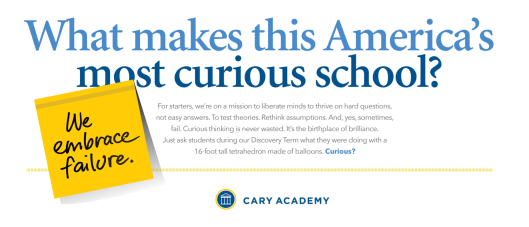Strategic Plan Update
We have completed the second year of our Cary Academy 2020 Strategic Plan.
Our Vision
Cary Academy will create learning opportunities that are flexible, personalized, and relevant. We will cultivate self-directed and bold life-long learners who make meaningful contributions to the world.
Goal 1: Institutional Flexibility
Cary Academy will create institutional flexibility to facilitate innovative and dynamic learning experiences.
Twenty years into our history, Cary Academy is boldly embracing our founding vision to challenge our thinking, expand our programs, and reimagine physical spaces to facilitate innovative and dynamic learning experiences for our community.
As we close our second year of our strategic plan work, we can look back on multiple accomplishments that have created a springboard for the next three years. As a perpetual motion machine is launched, we have identified mindset and meaningful curriculum review as the engines of deep educational reflection and renewal.
Mindset
Our teachers and staff continue to explore new approaches such as design thinking to promote more empathetic, creative, and action-oriented work in and out of the classroom. Middle School teachers shared some of these new classroom approaches with North Carolina colleagues at our fall educators conference. Upper School students participated in our first entrepreneurial competition, the Drink Cart Challenge, that came from a Business Office exercise with the San Francisco-based design firm IDEO. Both divisions have collaborated on a new schedule design that will allow us to offer more flexibility in the school day during its pilot year in 2017-2018.
Curriculum Renewal
Through these conversations online, blended, and experiential learning programs have all been augmented, allowing students more flexibility in how they fulfill personal learning interests and graduation requirements. Significant new course offerings and tracks of study have been developed in the Upper School arts, sciences, and physical education programs.
While many of these changes are intangible, our spaces, from furniture that creates more flexible learning environments, to collaboration spaces and community- centered office spaces, underscore the deep commitment that all community members are benefitted from this work.
Goal 2: Authentic Engagement
Cary Academy will foster the intellectual and cultural elasticity needed to adapt and thrive in the world.
Cary Academy continues to introduce new projects aimed at creating learning opportunities for students that allow them to explore topics of personal interest in real world context. Examples include:
- A doubling of the scope of our new Discovery Term Work Experience Program, from 25 internships in May 2016 to more than 50 in May of 2017. These hands-on experiences offer our students a chance to see first hand the inner workings of different professions and industries and learn from skilled practitioners — some have even transitioned into full summer internships.
- The launch of the Lenovo Scholars Program, in which participating students have mentorship lunches with Lenovo executives and participate in activities ranging from experimentation with new technology to visiting a distribution center.
- The creation of a new Advanced Biotechnology course that provides students with a learning experience founded in authentic research problems in collaboration with area scientists.
Students are not the only ones taking advantage of new opportunities to connect with the corporate community to learn. In an initiative sponsored by the Middle School Instructional Technology Team, nearly all Middle School faculty have now completed certification as Microsoft Innovative Educators, with particular emphasis upon the use of the OneNote application. Meanwhile, Cary Academy’s participation in the National SEED Project (Seeking Educational Equity and Diversity) has been expanded to include parent and student cohorts.
Looking ahead, a group of Upper School faculty is currently investigating the possibility of introducing a new year-long community-based civic engagement experience for students that will allow them to work with outside organizations to address real-world problems in the greater Triangle area.
Goal 3: Strong Communications
Cary Academy will strengthen existing relationships and build new connections to embrace multiple perspectives and opportunities.
The focus of our work in this goal area has been on both strengthening the ways that we communicate with our day-to-day community as well as build connections with our alumni and forge new partnerships.
Communications
Starting with a communication audit in 2015, we have embarked on developing a communications plan to refresh and align the school’s visual identity and strengthen our communications. This past year we embarked on a project with the Atlanta-based firm Mindpower to update key artifacts like our logo and create a comprehensive Brand Toolkit and corresponding website that can be used across our constituencies. This past year we launched our CA Weekly email to streamline communication and developed a social media action plan to further improve our use of these important tools.
Internally, we’ve launched a review of our communications structures, systems and tools. This review will extend into the third year of our strategic plan and is designed to help connect and streamline our various software packages such as internal and external web sites, calendaring programs, student information systems, and workflow reporting and management systems.
Connections
Our first TEDx event for students and alumni was a huge success and was an early part of a very successful year-long 20th Anniversary celebration that touched programs across the school. Our retrospective MusiCAl! was a fabulous walk down memory lane for our community and was able to incorporate alumni in some of the weekend performances. A purposeful partnership with parents, the Upper School, and the Alumni Office, led to a highly successful Career Connections program with our largest ever number of alumni speakers, including keynoter Uzma Rawn ‘02, senior director of sponsorships for Major League Baseball and a Forbes 30 Under 30 winner.
Collaborations
Our Research and Development Team is a cross-organizational group formed to look forward for new opportunities for the school. They, along with other project-focused teams, have spread out around the country to look at innovative practices at other schools and bring ideas to CA that fit our community and our mission. In addition, we have joined or formed new collaborations of top independent schools in the US and around the world to benchmark our programs and work to develop new opportunities for our employees and students. In the spring of 2016, we took a group of students to a social entrepreneurship summit at the American School of Bombay. New collaborations will take place with Nueva School in San Francisco in the fall of 2017 and with the American School of Singapore in the spring of 2018.
We also launched our Cary Academy Teaching Fellows program.
Goal 4: Appropriate Resources
Cary Academy will build the professional and learning environments necessary to realize our strategic vision.
We have been hard at work making sure that our human, physical, and financial resources can provide the supports necessary to meet our vision.
Human
After an evaluation of staffing ratios, we expanded some Upper School staffing levels to accommodate needs of current and new programs — ensuring that we keep class sizes at optimal levels and give our faculty the best opportunity to build individual connections with students. We’ve also reorganized and reassigned some staff to create better workflow for day-to-day operations and purchasing. As the start of an effort to review our compensation programs, we formed a working group to create Compensation Philosophy statement that could guide further work in this area. (See attached document.)
Physical
We continue to focus on maintaining and improving our campus to provide the best possible learning environment. Development of a Campus Master Plan launched this work, and in the past year we designed and renovated several new spaces, including:
- a brand-new Design Lab in Berger Hall for use by the Middle School,
- the renovation of our old lecture hall into a multipurpose presentation and collaborative space we are calling the Discovery Studio,
- a college counseling suite to accommodate an increase in counseling staff,
- a collaborative space for Upper School students that we are informally calling our “collab-a-lounge,”
- a multi-use classroom suite that quickly can be transformed from a large-scale workroom into two classrooms or three studios, depending on need.
Planning took place all year for a new science building that will be built adjacent to the SEA. We expect construction to begin this summer and last a year.
Financial
A Capital Campaign Steering Committee has been at work all year on the leadership phase of a fundraising effort to support our facilities and strategic plans.
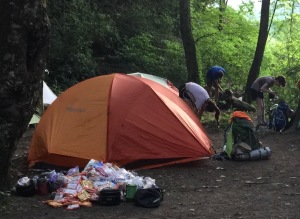


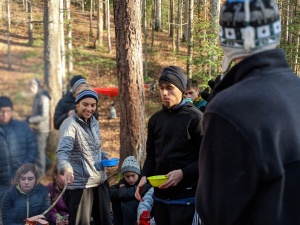

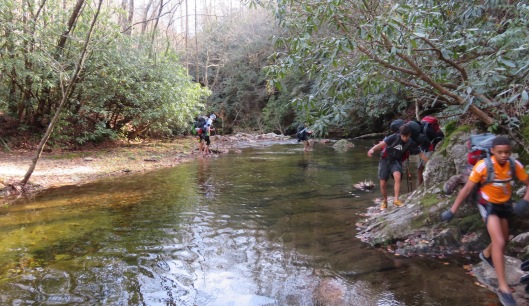




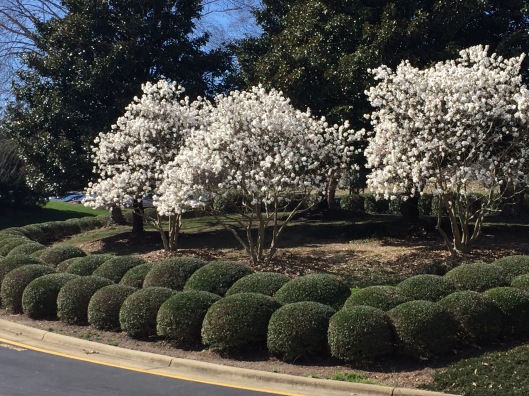
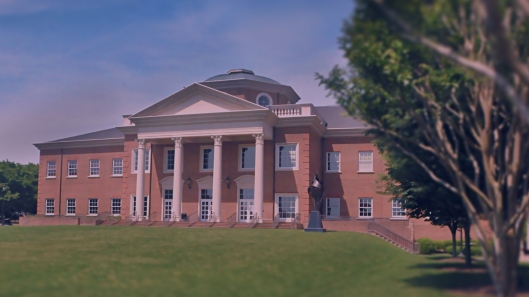
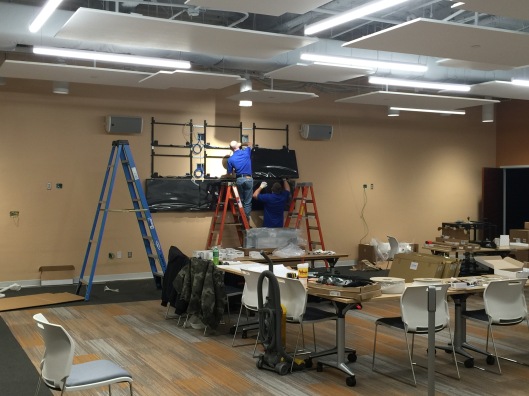
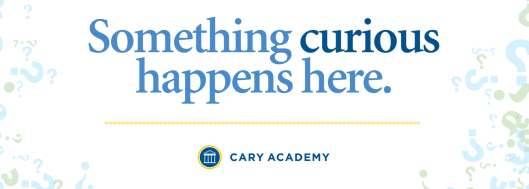
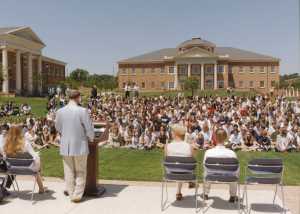
 The Future is Always Moving
The Future is Always Moving